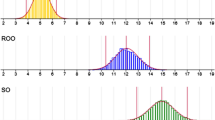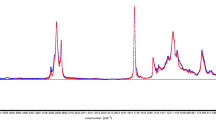Abstract
Adulteration of olive oil during the packaging process may take place by accidental contamination. The development of analytical methodologies which enable detection of adulterations is warranted, since the addition of refined vegetable oils to refined olive oil (ROO) at low percentages could be a very challenging task. For this purpose, refined soybean, sunflower, corn and rapeseed oil are used for ROO fraudulent operation. ΔECN42 could be used as a parameter for the detection of ROO fraud with 0.5% refined corn oil (RCO), 0.5% refined soybean oil (RSbO), 0.4% refined rapeseed oil (RRO) and 0.1% refined sunflower oil (RSfO). The global method can be used as an effective parameter in refined olive oil adulteration even at low levels: 0.4% of RCO and RRO, 0.3% of RSbO and 0.1% of RSfO. The sterol composition can be considered as good markers of purity. Linear discriminant analysis could represent the most discriminant variable and fast tool for evaluation of ROO adulteration.
Graphical abstract





Similar content being viewed by others
Abbreviations
- ROO:
-
Refined olive oil
- RSbO:
-
Refined soybean oil
- RSfO:
-
Refined sunflower oil
- RCO:
-
Refined corn oil
- RRO:
-
Refined rapeseed oil
- RCoO:
-
Refined corn oil
- FID:
-
Flame ionization detector
- FAME:
-
Fatty acid methyl ester
- GC:
-
Gas chromatography
- TAG:
-
Triacyglycerol
- HPLC:
-
High performance liquid chromatography
- IOC:
-
International olive council
- LDA:
-
Linear discriminant analysis
References
Drira M, Kelebek H, Guclu G et al (2020) Targeted analysis for detection the adulteration in extra virgin olive oil’s using LC-DAD/ESI–MS/MS and combined with chemometrics tools. Eur Food Res Technol 246:1661–1677. https://doi.org/10.1007/s00217-020-03522-y
Jabeur H, Drira M, Rebai A, Bouaziz M (2017) Putative markers of adulteration of higher-grade olive oil with less expensive pomace olive oil identified by gas chromatography combined with chemometrics. J Agric Food Chem 65:5375–5383. https://doi.org/10.1021/acs.jafc.7b00687
Frankel EN (2010) Chemistry of extra virgin olive oil: adulteration, oxidative stability, and antioxidants. J Agric Food Chem 58:5991–6006. https://doi.org/10.1021/jf1007677
International Olive Council (COI/ T.15/Doc no.3/Rev.9) (2018) Trade standard applying to olive oils and olive-pomace oils
Jabeur H, Zribi A, Bouaziz M (2016) Extra-virgin olive oil and cheap vegetable oils: distinction and detection of adulteration as determined by GC and chemometrics. Food Anal Methods 9:712–723. https://doi.org/10.1007/s12161-015-0249-9
Beccaria M, Moret E, Purcaro G et al (2016) Reliability of the ΔECN42 limit and global method for extra virgin olive oil purity assessment using different analytical approaches. Food Chem 190:216–225. https://doi.org/10.1016/j.foodchem.2015.05.075
de la Mata-Espinosa P, Bosque-Sendra JM, Bro R, Cuadros-Rodríguez L (2011) Olive oil quantification of edible vegetable oil blends using triacylglycerols chromatographic fingerprints and chemometric tools. Talanta 85:177–182. https://doi.org/10.1016/j.talanta.2011.03.049
Aparicio R, Conte LS, Fiebig H-J (2013) Olive oil authentication. In: Aparicio R, Harwood J (eds) Handbook of olive oil: analysis and properties. Springer, Boston, pp 589–653
Cortesi N, Rovellini P, Fedeli E (1990) I trigliceridi degli oli naturali. Nota I. Trigliceridi Degli Oli Nat Nota I 67:69–73
International Olive Council C 20/Doc. no. 20/Rev. 4 (2017) Determination of the difference between actual and theoretical content of triacylglycerols with ECN42.
Jabeur H, Zribi A, Makni J et al (2014) Detection of chemlali extra-virgin olive oil adulteration mixed with soybean oil, corn oil, and sunflower oil by using GC and HPLC. J Agric Food Chem 62:4893–4904. https://doi.org/10.1021/jf500571n
Lerma-García MJ, Lusardi R, Chiavaro E et al (2011) Use of triacylglycerol profiles established by high performance liquid chromatography with ultraviolet–visible detection to predict the botanical origin of vegetable oils. J Chromatogr A 1218:7521–7527. https://doi.org/10.1016/j.chroma.2011.07.078
Cert A, Moreda W (2000) Algorithms for the detection of hazelnut oil in olive oil. Grasas Aceites 51:143–149. https://doi.org/10.3989/gya.2000.v51.i3.470
International Olive Council ( COI/T.20/Doc.no.25/Rev.1) (2013) Global method for the detection of extraneous oils in olive oils.
Benitez-Sánchez PL, León-Camacho M, Aparicio R (2003) A comprehensive study of hazelnut oil composition with comparisons to other vegetable oils, particularly olive oil. Eur Food Res Technol 218:13–19. https://doi.org/10.1007/s00217-003-0766-4
Al-Ismail KM, Alsaed AK, Ahmad R, Al-Dabbas M (2010) Detection of olive oil adulteration with some plant oils by GLC analysis of sterols using polar column. Food Chem 121:1255–1259
Monfreda M, Gobbi L, Grippa A (2012) Blends of olive oil and sunflower oil: characterisation and olive oil quantification using fatty acid composition and chemometric tools. Food Chem 134:2283–2290. https://doi.org/10.1016/j.foodchem.2012.03.122
Moreda W, Pérez-Camino MC, Cert A (2003) Improved method for the determination of triacylglycerols in olive oils by high performance liquid chromatography. Grasas Aceites 54:175–179. https://doi.org/10.3989/gya.2003.v54.i2.262
Paquot C, Hautfenne A (1987) International union of pure and applied chemistry (IUPAC). Method 2.323. In: Standard methods for the analysis of oils, fats and derivatives, 7th edn. Blackwell, Oxford
EC Regulation No 258/97 (1997) EC Regulation No 258/97 of the european parliament and of the council concerning novel foods and novel food ingredients
Heaton K, Kelly SD, Hoogewerff J, Woolfe M (2008) Verifying the geographical origin of beef: the application of multi-element isotope and trace element analysis. Food Chem 107:506–515. https://doi.org/10.1016/j.foodchem.2007.08.010
Suhaj M, Koreňovská M (2008) Study of some European cheeses geographical traceability by pattern recognition analysis of multielemental data. Eur Food Res Technol 227:1419–1427. https://doi.org/10.1007/s00217-008-0861-7
Acknowledgements
The authors would like to acknowledge the support of the Ministère de l’Enseignement Supérieur et de la Recherche Scientifique (LR14ES08) and the Ministère de l’Agriculture (ONH Laboratory-Sfax), Tunisia, to this research work.
Author information
Authors and Affiliations
Corresponding author
Ethics declarations
Conflict of interest
The authors declare no conflict of interest.
Compliance with ethics requirements
This article does not contain any studies with human or animal subjects.
Additional information
Publisher's Note
Springer Nature remains neutral with regard to jurisdictional claims in published maps and institutional affiliations.
Rights and permissions
About this article
Cite this article
Jabeur, H., Drira, M. & Bouaziz, M. Targeted authentication approach for the control of the contamination of refined olive oil by refined seeds oils using chromatographic techniques and chemometrics models. Eur Food Res Technol 247, 2455–2472 (2021). https://doi.org/10.1007/s00217-021-03811-0
Received:
Revised:
Accepted:
Published:
Issue Date:
DOI: https://doi.org/10.1007/s00217-021-03811-0




